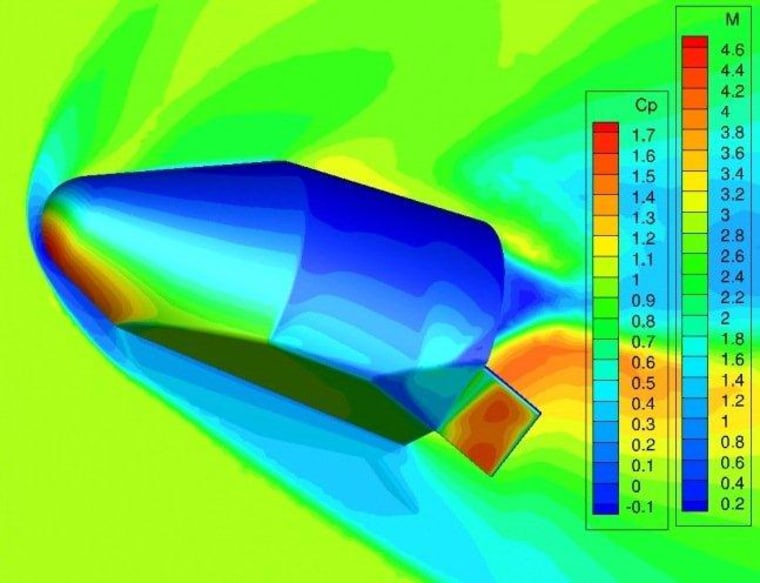
Executives at Blue Origin, the rocket venture founded by Amazon billionaire Jeff Bezos, have traditionally been reticent about discussing where they're going — but now that they're focusing in on development work for NASA, they're speaking out about their progress and their ambitions. And it turns out that those ambitions are ... well, pretty ambitious.
Like Armadillo Aerospace, Blue is developing a vertical-takeoff suborbital space vehicle for tourists and researchers. Like Sierra Nevada Corp., it's working on an aerodynamic spacecraft to carry NASA astronauts and other spacefliers into orbit. And like SpaceX, it's working on its own launch vehicles as well. The company may not provide many specifics about its timeline, but that doesn't mean the pace is lackadaisical.
"It's not a question of, 'Are we on some timeline,'" Brett Alexander, Blue Origin's director of strategy and business development, told me last week. "We've always said 'later in this decade' is when we're going to do it. Working with NASA will just accelerate us."
Alexander, who has worked on aerospace issues for more than two decades in government and industry circles, discussed Blue Origin's blue-sky ambitions as a follow-up to last week's news about a successful round of wind-tunnel tests for its orbital Space Vehicle, or SV. He said more than 180 runs were conducted at Lockheed Martin's wind-tunnel facility in Dallas to work out the right placement of aerodynamic body flaps on the aft end of the spacecraft.
The idea is that the flaps will enhance SV's biconic shape to give the capsule an extra bit of cross-range maneuverability "without the weight penalty and the complexity of wheels and wings," Alexander said. That could allow for a quicker return to orbit in the event of an emergency, since the SV could more easily be guided to a parachute-slowed descent over a designated land range.
May is a big month for Blue
Alexander said the resulting spacecraft design "will be officially blessed" at a system requirements review in May. Also during May, Blue Origin expects to begin testing of the thrust chamber assembly for its BE-3 rocket engine at NASA's Stennis Space Center in Mississippi, Alexander said.
The company, based in Kent, Wash., is receiving $22 million from NASA during the current phase of the space agency's program to help commercial ventures develop space taxis for the post-shuttle era. The SV isn't nearly as big as the space shuttle, of course, but it should be capable of transporting up to seven passengers to and from the International Space Station.
Alexander declined to say definitively whether Blue Origin would apply for further NASA funding during the next phase of the effort, known as Commercial Crew Integrated Capability or CCiCap. But with or without the money from NASA, Bezos and his team intend to create its their very own space transportation system.
"We started this design before NASA had the commercial crew program," Alexander said. "It was always our intention — and still is — to develop this."
He said that the plan calls for the "first few flights" to be launched on United Launch Alliance's Atlas 5 rocket, and that Blue Origin will eventually switch to its own launch vehicle with a reusable first stage.
Suborbital craft as 'pathfinder'
In parallel with its orbital development effort for NASA, Blue Origin is working on a separate crew capsule and propulsion vehicle that would blast off vertically for suborbital space trips. That part of the space program came into the spotlight last August, when Blue's unmanned test rocket went awry and crashed at the end of a supersonic test flight at Bezos' private spaceport in Texas. At the time, Bezos said that his team was "already working on our next development vehicle." Last week, Alexander said the development effort was "still under way."
In February, Alexander told Flightglobal that the suborbital crew capsule was undergoing testing, and that a pad-abort test would be conducted "in the summer sometime."
Although the funding arrangements for the privately backed suborbital program and the NASA-supported orbital program may be different, the two programs support each other technologically.
"Suborbital is definitely a pathfinder for our orbital system," Alexander said. The implication is that Blue Origin's rockets will be taking tourists and researchers to the edge of space significantly earlier than they'll be taking astronauts to orbit.
Bezos, whose net worth is currently estimated at more than $20 billion, doesn't strictly need NASA's money to pursue his long-held space ambitions. But Alexander said government backing will quicken Blue Origin's pace, and he argued against the sentiment in Congress that NASA should select just one company as the "leader" to go forward with spaceship development. Right now, NASA is supporting development efforts at four companies — the Boeing Co., Sierra Nevada Corp. and SpaceX as well as Blue Origin — and observers expect the field to shrink for the next round of funding. It's just a question of how much shrinkage there'll be.
"Competition is definitely better — better for the program, better for the country, better for the future of human spaceflight," Alexander told me. "If they down-select to one, it's no longer a commercial space program."
What do you think about Blue Origin's ambitions and the prospects for commercial spaceships? Feel free to weigh in with your comments below.
More about Blue Origin and Jeff Bezos:
- Blue Origin spruces up its rocket report
- How tycoons will fuel future spaceflight
- Bezos aims to bring up Apollo 11's sunken engines
- Cosmic Log archive on the commercial space race
Alan Boyle is msnbc.com's science editor. Connect with the Cosmic Log community by "liking" the log's Facebook page, following @b0yle on Twitter and adding the Cosmic Log page to your Google+ presence. You can also check out "The Case for Pluto," my book about the controversial dwarf planet and the search for new worlds.